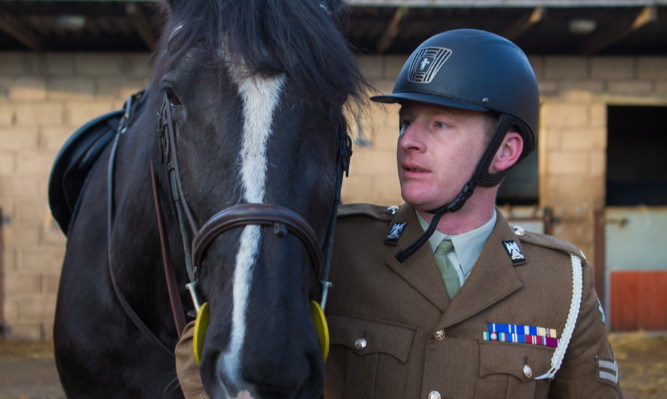The Army has defended its ownership of a taxpayer-funded regimental drum horse stabled in Fife following national questions over costs.
An Army spokesperson told The Courier that Talavera, the drum horse for the Leuchars-based Royal Scots Dragoon Guards (SCOTS DG), was part of a long-standing tradition of official military mascots, and helped carry out important ceremonial roles and duties.
The spokesman confirmed the estimated annual cost for the upkeep of Talavera, housed at Edenside Stables, Guardbridge,is around £1,500. This includes feeding, veterinary care, farrier, reduced cost livery and insurance.
Captain Ed Knox, SCOTS DG stables troop leader told The Courier: “As a cavalry regiment Talavera is key to the upkeep of our regimental identity, and therefore our regimental pride. This pride, ethos, distinguished history and the morale which that gives many of the regiment’s members is just one strand of what helps to make up the moral component of fighting power, in other words it is one part of what drives the soldiers to fight alongside their fellow men within the regiment.”
In a parliamentary answer published on Wednesday, Defence Minister Mark Lancaster revealed that Talavera is among nine taxpayer-funded mascots in the Army.
The others include goats, a wolfhound and two Shetland ponies.
Several of the animals also hold the rankings of fusilier and lance corporal.
Talavera, along with another drum horse Alamein, also known as Charlie, of the Queen’s Royal Hussars, are listed as unranked and are joined in this category by Domhnall of Shantamon, the Wolfhound of the Irish Guards whose rations are simply listed as “dog food”.
Kashmiri goats Fusilier Llwelyn, of the 1st Battalion The Royal Welsh, and Lance Corporal Shenkin III, of the 3rd Battalion The Royal Welsh, are listed along with Lance Corporal Derby XXX – a Swaledale ram representing the Mercian Regiment.
The final two mascots are both Shetland ponies – one known as Cruachan IV, a lance corporal with the Royal Regiment of Scotland and Pegasus V, a lance corporal with the Parachute Regiment.
The rations of the non-dog mascots are listed as “pasture forage and concentrate”.
An Army spokesperson added: “Talavera is one of a number of mascots in the armed forces, some of which are official, and thus attract a certain level of official funding to cover accommodation, movement, quarantine, veterinary services, bedding and rations. Other, unofficial mascots are maintained through private unit funds.
“Official military mascots are a long-standing tradition and carry out ceremonial roles and duties. The armed forces have a total of nine official mascots, all of which are attached to the Army.”
The Courier was this week given the chance to meet Talavera at Edenside Stables and the hard working staff who look after her.
A second army horse, a grey called Rose, is also housed there. She is owned by the SCOTSDG regiment and funded privately.
Talavera was gifted by the Queen in 2002, and in September, the monarch got more than she bargained for on a visit to Leuchars when she was slobbered on.
Drum horses played an important role in Army history sending messages across the battlefield.
Today their role is largely ceremonial.
A full feature on ‘A Day in the Life of Talavera’ will appear in The Courier magazine on Saturday January 23.
